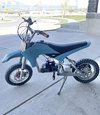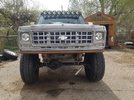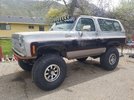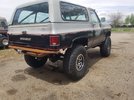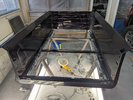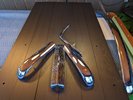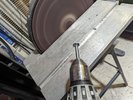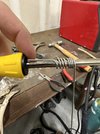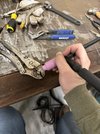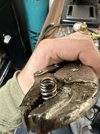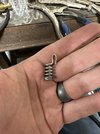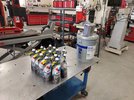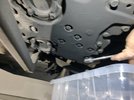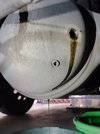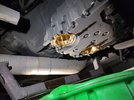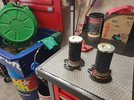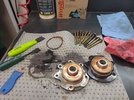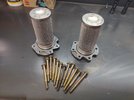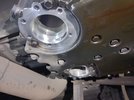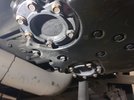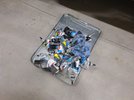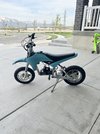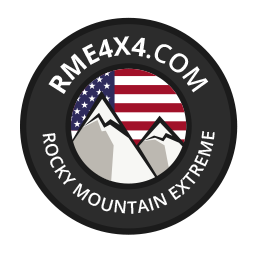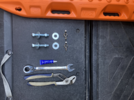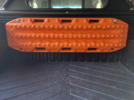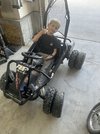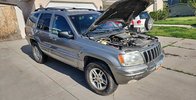The next project actually rolled into the shop on Monday evening but I was neck deep in yard work so I didn't get a chance to begin work on it until last night.
I have done some work for this gentleman on numerous occasions as he was a client when we had our speed shop and has also brought a few things to me over the last couple of years in our new shop. He just took possession of this Jeep a short while ago as he bought it with engine issues and really didn't get a chance to drive it before now. Once he got the powertrain back in running condition he quickly realized he had a pretty good case of death wobble and called to ask for advice seeing as how he is new to this Jeep thing. I recommended a few things to check and shortly after he called telling me he found the issue and we scheduled an appointment for him to drop it off.
Usually these issues arise on lifted Jeeps running oversize tires as they put more stress on suspension and steering components but I thought this one would be good to document to show that it can happen to a bone stock Jeep as well.
There are several things that can cause death wobble but a common one is the track bar holes being elongated. The issue seems to begin with a track bolt coming a little loose and then the back and forth stresses elongate the bolt holes, usually in the axle bracket but this one appears to be both with the bracket at the frame end actually being a little worse. The end result is usually a nasty case of death wobble that is quite often explained as a "near death experience".

Those that have had a case of death wobble know exactly what I mean and I've driven a few that definitely got my attention.

The Jeep racked and giving the suspension a good once over. I like to barely lift the Jeep to the middle of the suspension range so the suspension is neither fully drooped out with weight hanging on the components nor sitting at ride height with the suspension in compression with a load. By having it in the middle of the range I have found it easier to roll around under it on a creeper and with a prybar check each suspension connection point to check the bushings. Then I'll raise the Jeep up in the air a few inches to check front ball joints and unit bearings before raising it further to get a full view of the undercarriage.
Everything seems to be in order with the exception of the track bar where I was able to get a bit of play at both ends. Also worth noting is that both ends (axle and frame) are completely stock with no aftermarket components. There are several aftermarket companies that manufacture heavy duty brackets for these to address issues either as a direct replacement part or as preventative as a Jeep is being built. I've done upgrades for people under both situations but it's usually after the fact vs. preventative.
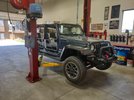
It's kind of hard to see but if you look around the 2 o'clock to approx. 5 o'clock range you can see where the head of the bolt has been moving. This is far from one of the worst cases I've seen but this is about when things start becoming noticeable that something is going on that isn't right.
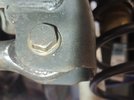
Not quite sure what is going on here as from the outside it looked like electrical tape but once I got it apart it almost took the consistency of RTV.
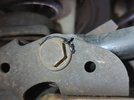
This case actually got bad enough that it wore the rubber encapsulated bushing in the track bar ends. The new owner attemped to stake the bushings in place just to buy some time until I could get it in the shop. The bushing was now firmly mounted in the track bar but unfortunately, the elongated holes in the brackets still allowed a substantial amount of movement.
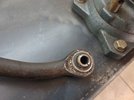
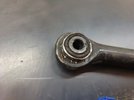
I also have found that there is just enough clearance in the new bushings and in new aftermarket track bars that the 14mm bolt can be replaced with a 9/16" bolt and therefore close up a few more thousands of clearance. I didn't think about putting the OEM 14mm bolt in the hole for a visual but I did put the larger 9/16" bolt in the hole and you can see how much the hole is elongated.
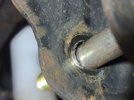
I've had some come in the shop that have been so severe that the bracket is either ripped from the mounting location or it has been damaged so badly that a complete bracket replacement is the only option. At that point I have used one of the various aftermarket brackets and welded them the Jeep after removing the OEM bracketry. This is a great option as they are also thicker than the OEM brackets, most are around 1/4" with a few only being 3/16" material. The factory bracket thickness seems to be about 10-gauge or slightly over 1/8" steel.
This Jeep fortunately was not that bad and a perfect candidate for a repair using weld washers. Now most probably know what a weld washer is as it is exactly what is sounds like, a washer welded to the outside of an existing hole to give the hole more thickness and therefore strength for the fastener. I've used weld washers as well as doubler plates on everything from race cars to Jeeps and even ATV's and sandrails as they are quite popular in the off-road and racing industries. They give the extra stength by adding thickness and therefore surface area for fasteners to capitalize on without having to make the entire brackets out of 1/4" or 3/8" thick plate. Strength without all of the extra weight is the main advantage. Those that have followed along with some of my previous work may note that when we built my son's suspension under his WJ that I machined weld washers and used them in multiple locations for mounting points.
Now the examples above were from the beginning of a project so the material is actually multiplied when using a weld washer. However, in a scenario such as this where the hole is damaged and there will be no support from the original material, I feel there is a better option. Most people I've seen do this repair just simply weld a washer to the outside of the hole in the bracket, bolt it back together and run with it. That is not the way I do this repair because it will only net you the support based on the washer being used and not to the tolerances I prefer. Most standard washers are made from 1018 or 1020 mild steel with a zinc coating and are only about .100" in thickness. This is less than the OEM material that wore away and therefore it is a repair with a relatively short shelf life.
I use a bit more intrusive method by machining a weld washer that is also taking the thickness of the OEM bracket into the equation. This takes it from a bandaid or temporary repair to a permanent repair that will be stronger and have a longer life than the OEM. It does take a bit longer and requires some machining but in my opinion, the only proper way to repair these.
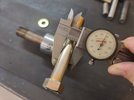
The slightly larger diameter 9/16" bolt is a much nicer fitment into the new track bar bushings.
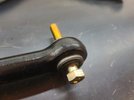
For this repair I like to reach for some old hydraulic rams that I keep a small assortment of. I've done a lot of hydraulic work over the years and I've kept the damaged or broken hydraulic rods as they are perfect for such repairs. If you look at most off-road parts suppliers that sell weld washers you will find most are machined from 1018 or 1020 mild steel. While there is nothing wrong with that, those grades are considered low carbon steel and I have found that most hydraulic rods are machined from 1045 mild steel, which is considered a medium carbon steel and extra carbon gives this grade excellent strength as well as wear characteristics. I dug through my remnants of hydraulic rods, which is getting low I might add as I haven't replaced a rod in several years. I found a complete 24" rod in that was 2" in diameter but that would require quite a bit of material removal to fit the OEM brackets. Upon further digging I found a couple of smaller drops in the 1.250" diameter which will be perfect.
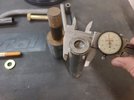
The 1.250" rod chucked up in the 6-jaw and being faced off.
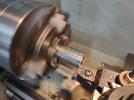
More pics to follow.......
, but if you charged the labor rate for the quality of your work deserves, it would probably be $250 an hour

